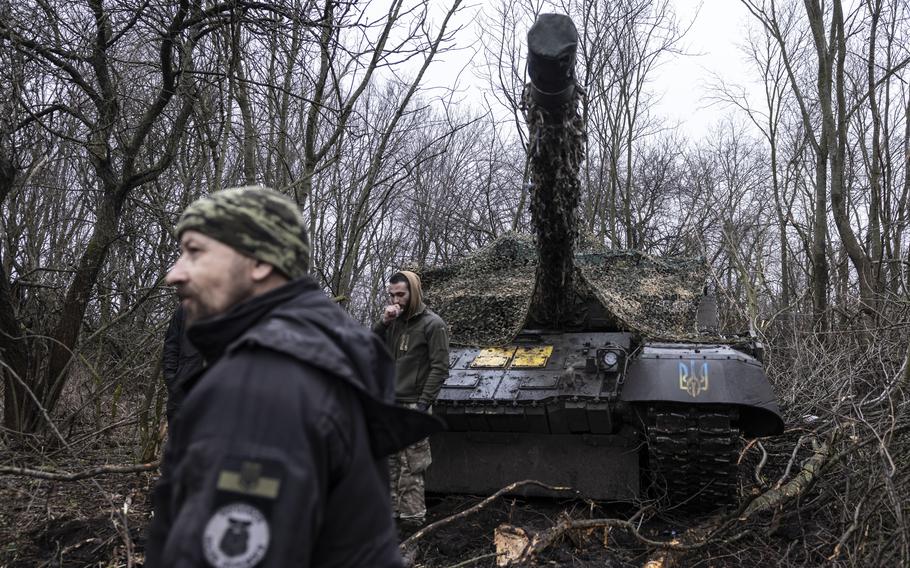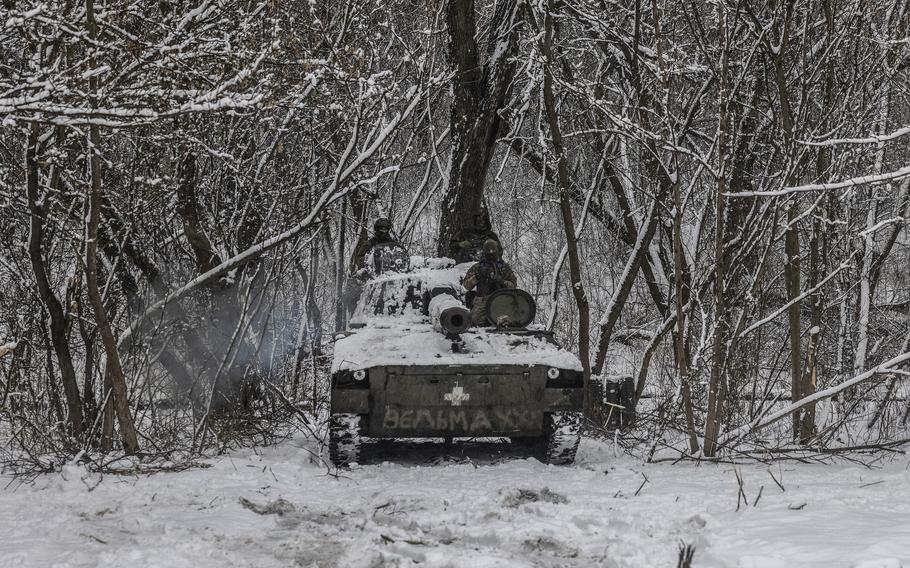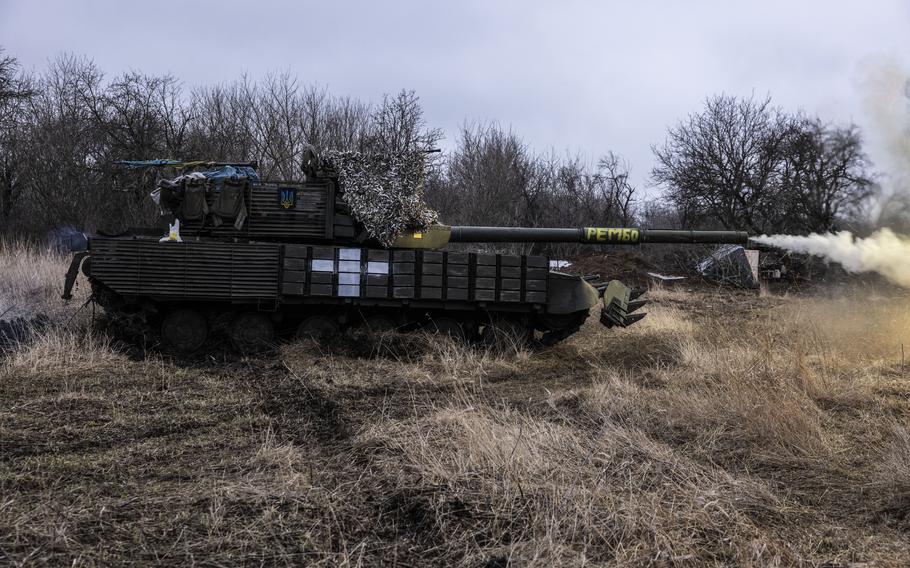Europe
Ukraine, pumped up by Western weapons, is held back by slow deliveries
Stars and Stripes March 22, 2023

Ukraine military mechanics work on a Soviet-era T-72 tank captured from the Russians in the Donetsk region of eastern Ukraine on March 19, 2023. (Heidi Levine/for The Washington Post)
KYIV, Ukraine — The United States and its partners are ramping up support for Ukraine’s military — including the Pentagon’s new plan to speed delivery of Abrams battle tanks and a decision by Poland and Slovakia to provide fighter jets — reflecting alarm over recent incremental Russian advances and the Kremlin’s tightening alliances with China and Iran.
But while President Biden has pledged to stand with Kyiv “for as long as it takes,” Ukrainian officials, Western diplomats and analysts warn that the help is simply taking too long. As both sides gird for a spring fighting season that could tilt the outcome of the war, Ukraine still lacks the force strength and weapons to fully expel the Russian invaders from its territory.
The announcement of fighter jets was highly symbolic and loudly applauded in Kyiv, but the Soviet-era planes are of limited use given the nature of the war, largely a close-range artillery fight in which neither side controls the skies. The Abrams tanks will add major armored muscle but won’t arrive until fall — some six months after an anticipated spring Ukrainian counteroffensive.
“What’s clear is that time is on Russia’s side, meaning it has the soldiers and materiel to grind out a long war along a massive front,” said Rachel Rizzo, an analyst in the Atlantic Council’s Europe program. “Ukraine doesn’t have that advantage. ... If weapons aren’t delivered fast enough, it makes it extremely difficult for Ukraine to push back against Russian gains.”
Delays aren’t the only challenge. Despite the professions of Western support, other key items on Ukraine’s weapons wish list remain unfulfilled. Kyiv is asking for everything from sophisticated equipment, such as American F-16 fighter jets and longer-range rocket artillery, to basic ammunition, especially shells for its existing Soviet-era tanks and artillery pieces.
Publicly, Ukraine’s leaders are projecting confidence, and voicing gratitude. “We expect increased supplies of exactly what we need,” President Volodymyr Zelenskyy said this week. “And we need it right now.”
Some of Kyiv’s supporters are clearly stepping up. Britain confirmed this week that it is sending Ukraine tank munitions with depleted uranium, rebuffing claims from Russian President Vladimir Putin that such shells have “a nuclear component.” The heavy metal aids in piercing tanks and other armor.
Germany, which initially equivocated over whether it would release Leopard tanks to Ukraine, now hopes to pull together two Leopard 2 battalions — totaling about 70 tanks, though repairs and checks still needed to be carried out on many of those vehicles, which were built in the late 1980s and early 1990s.

Ukraine forces tucked within a snowy forest on an S1 Soviet-era howitzer in the Donetsk region on Feb. 14, 2023. (Heidi Levine/for The Washington Post)
At the same time, there are palpable concerns that the West dithered too long.
“The side with more resources arriving faster has the upper hand on the battlefield,” said Ukrainian Foreign Minister Dmytro Kuleba. “Artillery ammunition is the highest priority. ... The faster we get more shells, the more Ukrainian lives will be saved; the more effective Ukrainian defense and counteroffensive operations, the sooner Ukraine will be able to end this war and restore peace through decisive battlefield victories.”
Estonia’s ambassador to Ukraine, Kaimo Kuusk, said NATO countries should have provided “more and faster ... [the] day before yesterday. But complaining will not change the past.” He added: “We should help Ukraine to change the future, at the moment.”
The Kremlin has denounced the United States and its allies for supplying weapons to Ukraine, angrily insisting that they are merely prolonging the conflict and delaying Russia’s inevitable victory.
Defenders of the incremental strategy say the West did as much as it could while successfully avoiding direct conflict with Russia, even though the approach undeniably cost Ukraine more casualties. The spring counteroffensive — intended to take back a large chunk of territory occupied by Russia — could prove a decisive test.
Ukraine is holding back certain soldiers from the bloodiest front lines in the country’s east, where neither side has made notable territorial gains recently. Those troops will make up newly assembled assault brigades, and many have been receiving training abroad on new equipment that Western countries have promised to Ukraine.
Kyiv, for instance, is creating special battalions for the fighting vehicles and tanks that Western nations are providing, officials said. A battalion organized around U.S.-provided Bradleys will have about 30 of the fighting vehicles.
But even those already pledged supplies could face further delays if supply lines and transport hubs are overwhelmed by equipment deliveries, potentially giving Russia an upper hand.
One European diplomat expressed hope that after the announcements by Poland and Slovakia, other supporters would also supply aircraft. “Polish jets’ main significance: breaking a glass ceiling — showing that giving fighter planes is not a taboo, and will not lead to a World War III,” the diplomat said.
But at a House hearing last month, Pentagon policy chief Colin Kahl rejected suggestions that Ukraine would be more successful in the short term if the United States granted its requests for F-16s. Manufacture and delivery of new planes would take many years, he said, and even shipment of existing aircraft would take at least 18 months, as would training of Ukrainian personnel.

Ukraine soldiers test-fire a T-64 tank in a field in the Donetsk region on March 19, 2023. (Heidi Levine/for The Washington Post)
Supplying even half the number of requested planes, he added, would also be overly expensive, and U.S. officials have stressed that extensive air defenses on both sides have made combat aircraft of limited value to Ukraine and Russia alike.
But in an interview with The Washington Post in February, Col. Gen. Oleksandr Syrsky, Ukraine’s ground forces commander, said the main value of modern fighters such as F-16s is their long-range strike capability. Russian forces have adjusted to Ukraine’s use of the U.S.-provided High Mobility Artillery Rocket System, or HIMARS, which has a range of about 50 miles, by moving many of their ammunition depots and logistical bases beyond that distance, Syrsky said.
“If we are talking about aviation, we are not talking about aircraft as such. We are talking about aviation platforms with a specific set of missiles, long-range missiles,” Syrsky said. “An increase in range will automatically move the front line, and the enemy’s capabilities will radically diminish.”
On the ground, Ukrainian tank crews have long yearned for modern battle tanks — both to give them an edge over the Russians and to better protect them if hit.
Washington’s accelerated delivery plan for the Abrams was greeted with tempered enthusiasm by leaders of the 17th Separate Tank Brigade. In an interview in the eastern Donetsk region, where he is deployed, the chief of staff for the 1st Tank Battalion, who goes by the call sign Wolf, said that “it’s relevant, but only if they’ll give more M1A2s further down the line.”
“They’re probably choosing not to give us their best weapons immediately but do it step by step,” Wolf said, referring to the Pentagon’s decision to send the older model M1A1 Abrams tanks faster instead of providing the more advanced variant, which could have taken a year or more to build.
For now, the Ukrainians are operating with a hodgepodge of their own Soviet-era equipment and armor captured from the Russians.
The T-64, a workhorse of the Ukrainian tank fleet, was fielded in the 1960s, and tanks built on the model have since received better armor and electronics. But soldiers said even those upgrades cannot compete with Western tanks like the Abrams, which are dripping in technology like advanced optics.
For Ukraine, one advantage of older tanks like the T-64 and T-72 over Western systems is that crews and mechanics know how to use and maintain them. One soldier said a T-64 can be fixed quickly with “[crud] on a stick,” using an expletive to describe how soldiers make repairs in the field with few resources.
By contrast, the Abrams carries a high logistical burden, the Pentagon has said, with officials expressing concern that the Ukrainians will struggle with support and maintenance. “The Abrams tank is a very complicated piece of equipment,” Kahl told reporters in January. “It’s expensive. It’s hard to train on. It has a jet engine. I think it’s about three gallons to the mile of jet fuel. It is not the easiest system to maintain.”
Rizzo said that even if the United States moves to deliver the Abrams as fast as possible, “we just don’t know where this war will be six months from now.”
Some officials and diplomats acknowledge that the West’s strategy has come at a cost to Ukraine, but say it also reflected the political realities of mustering a broad, international coalition.
“I’m sure it would have been nice to be where we are now six months ago,” Mark Gitenstein, the U.S. ambassador to the European Union, told journalists late last month. “And I think it would have made a difference. But I don’t think it was possible to move it any faster than [Biden] was able to move it. And he had to bring the American people along, too.”
Galouchka and Horton reported from the Donetsk region. The Washington Post’s Karen DeYoung in Washington and Serhiy Morgunov in Kyiv contributed to this report.